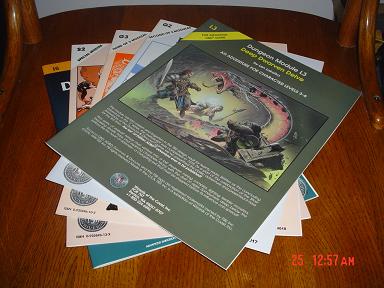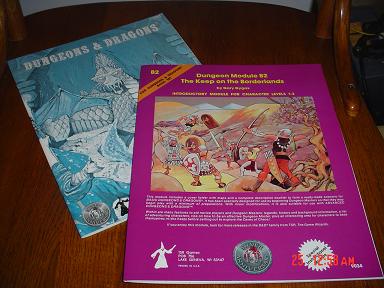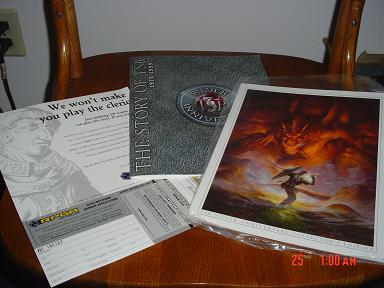TSR Silver Anniversary
Collector's Edition
In 1999, TSR was all but
totally acquired by Wizards of the Coast. The company had suffered through
financial ups and downs from the early 80's on, and was in the middle of a
financial crisis as the new decade, century and millennium loomed. Wizards of
the Coast stepped in and saved the Dungeons and Dragons product line, going
"back to formula" and releasing D&D under the "d20" rule system as the flagship
product of that particular experiment in publishing.
However, before TSR gave up
the ghost, one final product was released: The TSR Silver Anniversary
Collector's Edition. Even though this item appeared right around the time
this author was reacquainting himself with D&D, I initially shirked at the price
and apparent lack of completeness. So "my" copy sat on the shelf of a local
game store, un-purchased, for nearly three years thereafter.
|
What
finally prompted me to pick the box up was my desire to have a "complete"
set of pastel "Against the Giants" modules (which, ironically, my box didn't
contain - but more on that later). So with cash in hand, I purchased the
set. As it was a "limited edition" (five thousand copies, if I recall
correctly), not everyone got to see what the fuss was about. With that in
mind, let's have a look at the set and I'll give my views on the overall
packaging.
|

The included
AD&D modules. Not pictured: G1 |
Firstly, usable
content-wise, the box contains several "classic" modules: B2 Keep on the
Borderlands, G1 Steading of the Hill Giant Chief, G2 The Glacial Rift of the
Frost Giant Jarl, G3 Hall of the Fire Giant King, I6 Ravenloft, and C2 White
Plume Mountain. All of these modules are newly printed and bear a "Silver
Anniversary" logo in the lower left-hand corner. They are otherwise identical
to the modules released so many years ago. It should be noted that the copy of
B2 Keep on the Borderlands is a later printing of that classic module; the major
differences are reflected in the lack of a "Dexterity" statistic for monsters
and the adherence to the three cardinal alignments rather than the six as
presented in J. Eric Holmes' D&D edition.
|

All you need
now is a set of dice and a couple of eager players! Note the
ubiquitous "TSR Silver Anniversary" logo present on the rulebook and on all
the modules. They're otherwise identical to the originals. |
Speaking of the good Doctor,
the box also contains a facsimile of the original stand-alone D&D rulebook
with the monochrome David C. Sutherland artwork featuring a wizard and a
fighter squaring off with a red (?) dragon. Combined with the included B2,
it could be argued that the set contains a complete ready-to-play edition of
D&D! |
The rest of the box's
contents consist of a brief "Story of TSR" booklet, a limited edition art plate
by Jeff Easley, an RPGA sign-up form and lastly a copy of L3 Deep Dwarven Delve,
ostensibly by Leonard Lakofka.
I'll get L3 out of the way
first by saying simply this: anyone who's done a little bit of research about
the "version" of Deep Dwarven Delve included in the TSR Silver Anniversary Boxed
Set knows that the "module" is an insult to it's author. When TSR went trolling
for some new hook to get old gamers to purchase the set with, they contacted Len
Lakofka after his notes for Deep Dwarven Delve were found at TSR's Lake Geneva
offices. He corresponded with TSR authors, cleaned up his notes, went through a
lengthy editing and Q&A process for the module, mailed it back to TSR who
promptly lost the manuscript in it's entirety. That's right. A genuine
First Edition Advanced Dungeons and Dragons adventure penned by the author who
brought us L1 The Secret of Bone Hill and L2 The Assassins' Knot was lost by
that pack of bungling incompetents at TSR.
Rather than start anew, TSR
simply threw together the few notes they didn't manage to lose, and
issued them with horribly substandard maps and bindings. The module at a glance
appears like an AD&D 1st Edition product - but even a cursory inspection shows
the falsehood. The cover of the module is stapled on, for starters. The back
outside plate of the module is blank - no artwork, no TSR product list,
nothing. The interior font, while adhering to Century Gothic, is oversized;
additionally the margins and spacing are all wrong. Furthermore, the artwork
inside is obviously an attempt to recapture the feel of David A. Trampier, D.C.
Sutherland III, David S. Laforce et. al., but it comes off as a poor
imitation. All of that is of course secondary to the fact that the content
itself is incorrect but it adds insult to injury. An ingratiating editorial
from Peter Adkinson in the aforementioned "History of TSR" booklet gushes about
how the module is the same but different and is designed not to evoke memories
of old modules played but to be a new experience and I couldn't even be bothered
to waste more time reading his thinly veiled excuse for letting the mistake that
L3 became occur. I can only hope that Len Lakofka got due recompense for the
work he did, whether Wizards of the Coast or TSR used it or not.
|

Extraneous stuff or
real contents, depending on your point of view. |
This brings us
to the second highlight, the "Story of TSR" booklet. The booklet itself is
easily divided into three parts: an introduction by E. Gary Gygax, a
timeline section covering the "history", and a section containing various
remembrances and anecdotes from former TSR staffers. Most of these latter
stories are amusing and lend themselves to a feeling of nostalgia. Those of
us who weren't there get a glimpse at what must have been (during the good
times) a fun place to work and fun people to work with. Gary's introductory
piece is well written (as most of his efforts are). The "History of TSR" is
as sanitized and sterile as a history of that troubled company can be.
Beset almost from day one by lawsuits, despite it's impressive output of
fantasy games the feelings of acrimony among several management folks
must've run pretty high indeed. However, any detail of those turbulent
events would by necessity be one-sided and in taking a side, old wounds
could be opened and indeed accusations leveled that might end in more
litigation. So while the mudslinging might be fun to read about from afar,
we gamers will have to make do with what information we have. Maybe in
twenty years or so a truly accurate and envenomed tell-all will be
published. |
The remaining item, Jeff
Easley's art print, is serviceable fantasy art, I guess. It does nothing
special for me, and doesn't evoke any real feeling about how the game has
impacted me at all, truly. That's no criticism of Mr. Easley; I for one love
his artwork for TSR's Star Frontiers, but beyond that...
As I mentioned earlier, to
my dismay when I purchased and opened the set I discovered that instead of a
copy of G1 G2 and G3, mine contained two copies of G2 and one G3! I knew
it was a long shot, but I emailed customer service at Wizards of the Coast and
asked if there was even the remotest chance of getting the G1 replaced - of
course not, they said, but they'd be happy to trade the product for something
else. Considering that Wizards of the Coast no longer supports AD&D, I passed.
However, I was lucky enough
to receive a copy of G1 from Mike "Sieg" Stewart, adventure author for Troll
Lord Games and fellow Dragonsfoot.org message board member! So I thank you,
Mike, for helping make my set complete!
| In the final analysis, the
usefulness of the TSR Silver Anniversary Collector's Edition is actually
fairly high: seven complete modules and a rulebook (although six of the
seven modules are for Advanced D&D). Is the set worth it if you already
have the six easily available modules? Probably not. While Len Lakofka's
notes masquerading as a module are an interesting diversion, due to their
incompleteness and the failure of TSR to publish a complete adventure, I
cannot recommend that alone as a reason to purchase the set. The "Story of
TSR" and J. Eric Holmes D&D edition are also high points, but again don't
really make it a "must buy". |

The box forms a
handy storage case. |
Overall, if you already have
the material contained in the set save the spurious L3 and the "Story of TSR",
odds are you're better off not purchasing the box. On the other hand, if you're
missing a pastel module or two or have a burning desire to own L3 and/or the
aforementioned TSR history, then this might suit your needs. As with many
products I've reviewed, this one is out of print and getting scarce as
collectors part it out for individual module sales so if you happen to see one
somewhere for a low price, I'd go ahead and buy one.
Presentation - 9
Layout - 9
Art - 6 (low marks for L3,
high marks for all else)
Playability - 8
Compatibility to AD&D
- 9 (it's almost entirely comprised of AD&D modules...)
HOME
Reviews



